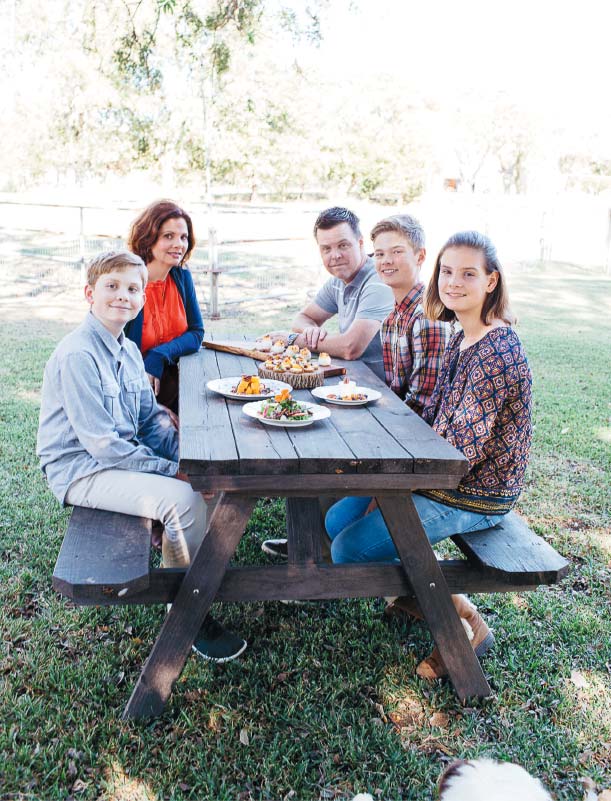
George and Katie Brown with (from left) Oliver, William and Clementine.
Photography by Melinda Ortley
“GEORGE” shouts the sign—a multi-colored, all-caps, plastic affair overlooking George and Katie Brown’s dining area, where five distressed- metal bistro chairs hug a spare, round table.
It’s where the Browns’ top-tier dining past—the sign is a memento from their restaurant—collides most overtly with their down-home present. This is the Lucas farm north of Dallas where they’re raising triplets, now 13, along with chickens, cows, sheep, donkeys and a horse. From the modest, 1930s brick house, the couple “commutes” across their deck to a plain, low-slung building beneath pecan and hackberry trees out back—their offices for Experimental Table catering and Bandera Foods, corporate mothership for their Killer Pecans. It’s a long way from the pinnacle of Dallas fine dining.
In 2004, the acclaimed, two-chef team—he’s the savory guy, she’s the pastry chef—were at the top of their game with the debut of George the restaurant, taking over the celebrated Riviera space (now Fireside Pies) on Inwood south of Lovers. They’d already been turning heads at high-end events with George Catering since 1999. And their resumes listed some of the city’s top kitchens, including The Rosewood Mansion on Turtle Creek and Baby Routh.
Then they got a life-changing surprise.
“The kids were born in 2004,” George says, the result of a last-ditch attempt to conceive. He and Katie knew twins were possible. But three babies! “That’s when we decided to downsize, to facilitate parenting…. Kids are life-changing things.” So they shuttered the restaurant and again concentrated on catering.
Today, Experimental Table amplifies the strong farm-to-table focus the Browns started at George Catering, and the spiced pecan biz is thriving. Home life centers around Clementine, Oliver and William.
With the kids at school, George walks me around their 10-acre patch, sandwiched between Lovejoy High School and housing developments. Katie still has her apron on when she joins us about halfway through. The couple shrug off suburbia’s encroachment. For the next six years, until the kids graduate from high school, they’re staying put.
When they first moved to the Lucas from Dallas’ Lakewood neighborhood in 2012, their dreams of farm life rapidly gave way to what was doable. Those fallow garden beds in front of the doll-house-like, olive-and-red chicken coop are gentle reminders of one lesson learned. They proved to be too time-consuming with three feisty 8-year-olds. Someone also told Katie that chickens would aerate the soil.
“No,” Katie says flatly, “they don’t. They kill your grass. They’re taking off the top soil to get to worms.” Now the chickens roam close to the residence by day, roost in their little house at night. The Browns grow just the herbs they need in a smaller garden—away from the chickens and by the pasture where their cows and sheep live.
“We let our pastures get overgrazed,” Katie says. Overgrazed and mulched wrong, George adds, when I ask about a big mound out behind the horse-and-donkey stables. After they put the mulch down over one whole pasture, he says, they had to scrape it up into the huge pile because they hadn’t let it cure properly. As newbies to country life, he says they were often in too big a hurry. George grew up in Richardson, and Katie, in Lake Jackson near Houston.

George restaurant memento
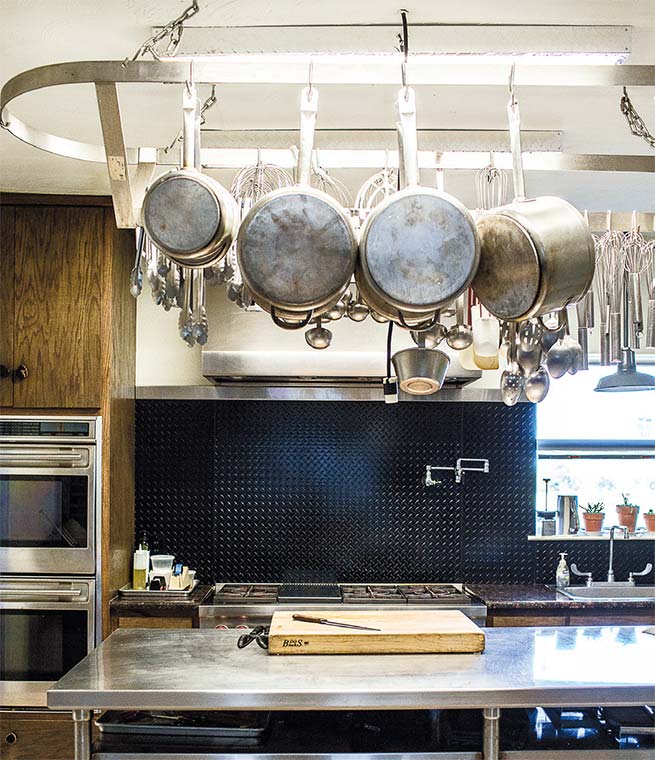
their test kitchen
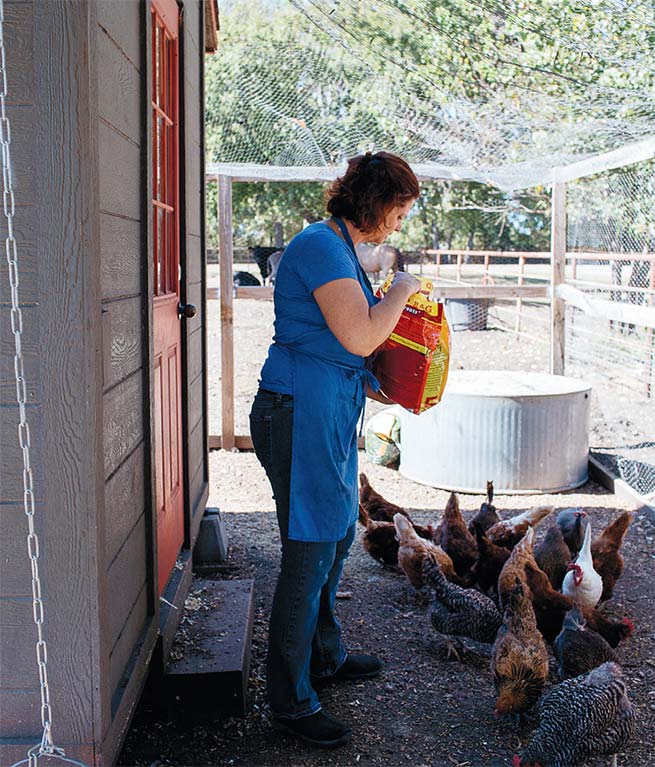
Katie feeding the chickens.
The stables came with the farm, where today Clem keeps her quarter horse Ponca and a couple of donkeys. It’s where the Browns initially tried their hand at raising pigs—creatures that are now out of the picture. George smiles and recounts all the ways they weren’t prepared to be hog farmers, how he’d do it differently next time and how much harder it is than it looks.
“(Today) everybody kind of has their job,” Katie says, hinting at the organization that keeps the farm running smoothly. “Clem takes care of her horse… and does the chicken feed and supervises the two donkeys.” Jughead the donkey brays a mega-decibel welcome when he sees me. “William does the chickens’ water…(and) collects the eggs.”
“We eat farm eggs four days a week,” George says, thanks to their 30-to-40-chicken flock. That still leaves plenty for catering. “Oliver is responsible for overseeing the lambs’ and cows’ water and food,” George adds. He also takes care of a rabbit.
Already believers in organization before the triplets, George and Katie took it to a new level when the babies came. Now it undergirds everything they do, albeit loosely, whether a crisis or just getting three kids to different activities on time. “We’ve had to bottle-feed [newborn] pigs and kittens at two-hour intervals,” George says— triggers for early triplet déjà vu, requiring a schedule and a raft of volunteers.
“Farm animals are pretty low maintenance until they’re sick,” Katie says. “The most high-maintenance thing we have (today) is the dog.” George explains that the idea of sourcing direct from small farms is something he started long ago with George Catering, when it was more challenging. “In George Catering and at Seventeen Seventeen (defunct, at the Dallas Museum of Art), we were pulling in farm food.” That was an era when several Dallas restaurants were struggling to source locally, but the system hadn’t quite gelled. “(Today) farms are doing a better job,” George says. “Guys like Rick Wells bring it together.” The McKinney restaurateur and his wife Robbin own Water Boy Farms in Lucas, which supplies fresh fruit, vegetables and honey to his restaurants, Harvest and Rick’s Chophouse. He’s also at the heart of a network of North Texas growers and chefs.
Another voice in that group, chef Robert Lyford of Patina Green Home and Market, introduced George to Megan and Jack Neubauer, the daughter-father team who own Pure Land Organic on the northwest side of McKinney. Their tomatoes were a perfect replacement, George says, for J.T. Lemley’s after the legendary Dallas Farmers Market grower retired. The Neubauers, he says, “grow amazing tomatoes….(Megan) does an Golden Nugget. I get kind of spoiled on those.”
Experimental Table still thrives on word of mouth as the Browns turn more attention to growing Bandera Foods, their onetime “side” enterprise. It started with Killer Pecans—Texas pecans seasoned with George’s secret blend of hand-mixed spices. Back at Seventeen Seventeen, George made a spinach salad with spiced pecans, and people started asking where they could buy them. Killer Pecans evolved from that.
“The Killer Pecans are sweet and spicy—just like Texas,” Katie likes to say. She took over running the business in 2013 after they bought out their partner. “We’re trying to build it out to be less seasonal,” she says. “In the South, people are very nostalgic about pecans.”
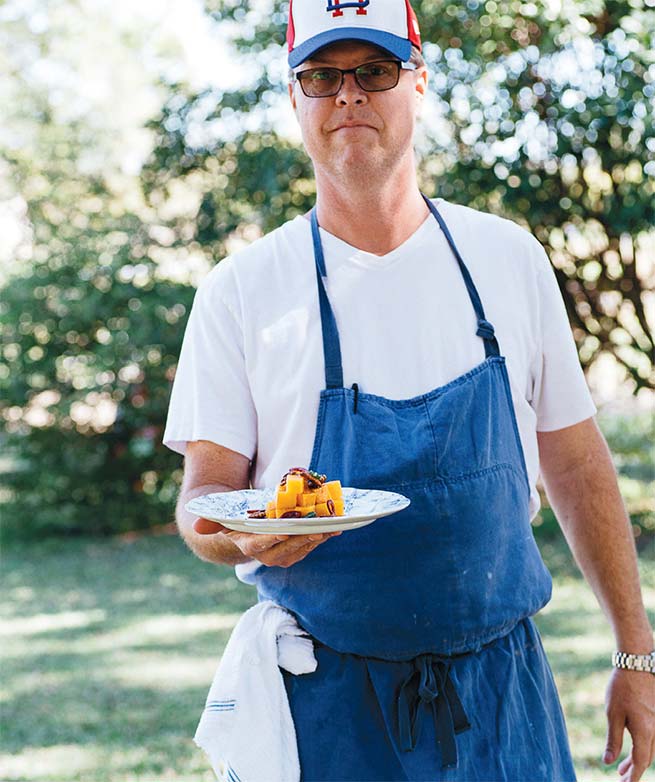
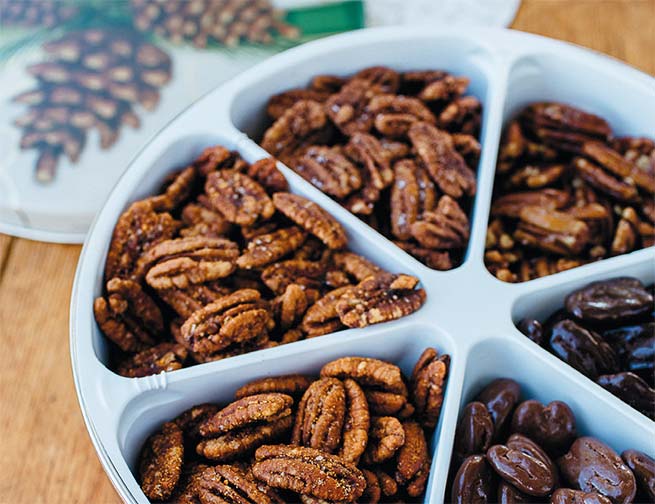
George makes his butternut squash with Killer Pecans, one of six varieties he crafts.
They’ve expanded the line to include Smokin’ Pecans (akin to George’s original Seventeen Seventeen spiced pecans), Rosemary- Olive Roasted Pecans and Cinnamon Pecans as well as milk-chocolate- and dark-chocolate-dipped Killer Pecans, Killer Pecans Shortbread Cookies and Killer Spice Rub. My favorite is the Killer Pecans Shortbread Cookies, where Katie’s influence is unmistakable in the perfect, tender crumb.
Tracing this relationship back to its beginnings at the original Culinary Institute of America, Hyde Park, New York, seems like ancient history. But that’s where the chefs met in 1991, at the height of the modern American food movement.
“We were the only two Texans in our class,” George says. “We got married, and the rest is history.” Even if it’s not the history they expected. Just ask Clementine, Oliver and William.
Brown Family Holiday Recipes
These recipes from George and Katie Brown call for their Bandera Foods flavored pecans, but you can substitute simple roasted pecans to great effect. To roast pecans, mix 1 teaspoon salt with 1½ tablespoons melted unsalted butter. Toss with 2 cups pecan halves to coat. Spread on a baking sheet and roast in a preheated 350°F oven for 10 minutes, or until nuts turn brown and aroma fills the air.
Sweet Potato Deviled Eggs with Smokin’ Pecans
Navel Orange with Marmalade, Farmstead Cheese, Basil and Killer Pecans on Toast
Roasted Butternut Squash with Killer Pecans, Crème Fraiche, Ribb on Cane Syrup and Fresno Chiles
KIM PIERCE is a Dallas freelance writer and editor who’s covered farmers markets and the locavore scene for some 30 years, including continuing coverage at The Dallas Morning News. She came by this passion writing about food, health, nutrition and wine. She and her partner nurture a backyard garden (no chickens – yet) and support local producers and those who grow foods sustainably. Back in the day, she co-authored The Phytopia Cookbook and more recently helped a team of writers win a 2014 International Association of Culinary Professionals Cookbook Award for The Oxford Encyclopedia for Food and Drink in America.
-
Kim Piercehttps://www.edibledfw.com/author/kpierce/
-
Kim Piercehttps://www.edibledfw.com/author/kpierce/
-
Kim Piercehttps://www.edibledfw.com/author/kpierce/
-
Kim Piercehttps://www.edibledfw.com/author/kpierce/











